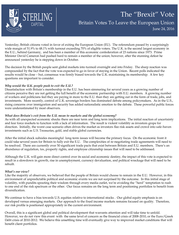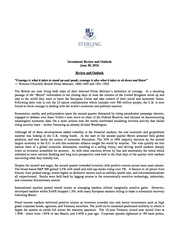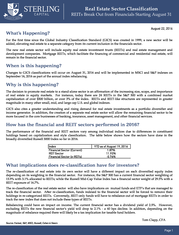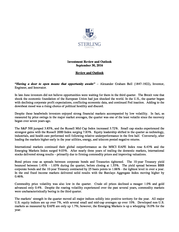Description
Behavioral Finance
360°Behavioral View
September 2015
Eventually, the sum total of the losses of the trades made to cover up other trades
compounded. Leeson took on more risk and engaged in more rogue trades. In the end he lost
over $1.4 billion of his employer’s capital.
Things are not what they really are. Rather, they are what we think they are.
Ultimately, we are all prisoners of how our minds perceive and frame investment situations. At Sterling, we recognize the difficulty involved with separating the biases that enter into the appraisal of a situation or portfolio opportunity at the moment of perceiving it from what it might actually be in reality. As a result all of our behaviorally driven portfolios are designed to intentionally remove the portfolio managers personal bias or opinion from the decision making process.
We seek to intentionally remove the bias that can be inherent in our own framing and instead rely on the strength of our behavioral stock ranking investment process. FOR INSTITUTIONAL USE ONLY. NOT TO BE DISTRIBUTED OR COMMUNICATED TO THE GENERAL PUBLIC The opinions contained in the preceding commentary reflect those of Sterling Capital Management LLC, and not those of BB&T Corporation or its executives. The stated opinions are for general information only and are not meant to be predictions or an offer of individual or personalized investment advice.
This information and these opinions are subject to change without notice. Any type of investing involves risk and there are no guarantees. Sterling Capital Management LLC does not assume liability for any loss which may result from the reliance by any person upon such information or opinions. 3 .
Ultimately, we are all prisoners of how our minds perceive and frame investment situations. At Sterling, we recognize the difficulty involved with separating the biases that enter into the appraisal of a situation or portfolio opportunity at the moment of perceiving it from what it might actually be in reality. As a result all of our behaviorally driven portfolios are designed to intentionally remove the portfolio managers personal bias or opinion from the decision making process.
We seek to intentionally remove the bias that can be inherent in our own framing and instead rely on the strength of our behavioral stock ranking investment process. FOR INSTITUTIONAL USE ONLY. NOT TO BE DISTRIBUTED OR COMMUNICATED TO THE GENERAL PUBLIC The opinions contained in the preceding commentary reflect those of Sterling Capital Management LLC, and not those of BB&T Corporation or its executives. The stated opinions are for general information only and are not meant to be predictions or an offer of individual or personalized investment advice.
This information and these opinions are subject to change without notice. Any type of investing involves risk and there are no guarantees. Sterling Capital Management LLC does not assume liability for any loss which may result from the reliance by any person upon such information or opinions. 3 .









